Today’s Strange Looking Tri Bikes

There’s a new kind of strange looking bike in triathlon. Actually, there’s more than one of these and if three brands makes it critical mass then we've achieved critical mass, and that makes it worth talking about.
These are the bikes with the triplane front ends and that’s my own term for lack of a better one. I’ll explain further below why I call it that, but let me name the bikes to which I refer. The first that I saw of this type was the Specialized Shiv Disc. The hallmarks of that bike were its widely-set-apart fork blades, and those blades traveled up past where the fork crown would normally be. The blades terminate at the top of the head tube or even higher. The front of the bike looks as if it were on crutches and it's the Shiv Disc that's pictured below.
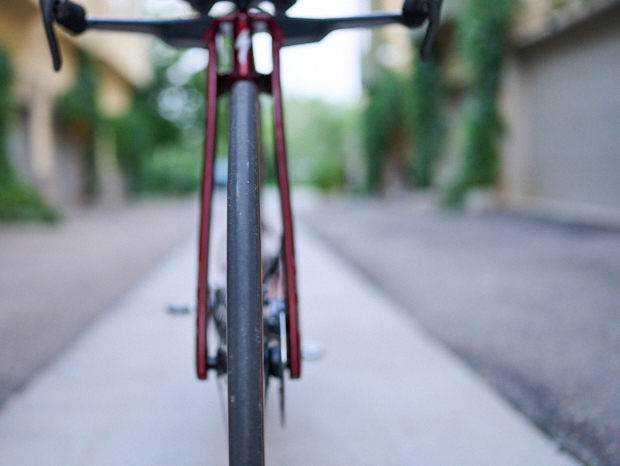
The next bike that had these blades was the bike by Kú Cycle, and this is truly the strangest looking of the three. That's the image highest up and I'll discuss this bike in due time. The third such bike was the CADEX ridden by most notably Kristian Blummenfelt but also in the most recent Hawaiian IRONMAN Maurice Clavel. When this motif is exploited to the full the fork blades remain the same distance apart from the bottom of the fork – at the fork ends – to the top of the fork, which is as I wrote past the top of the wheel and all the way up past the top tube and to the handlebars. Here’s Blu on his CADEX.
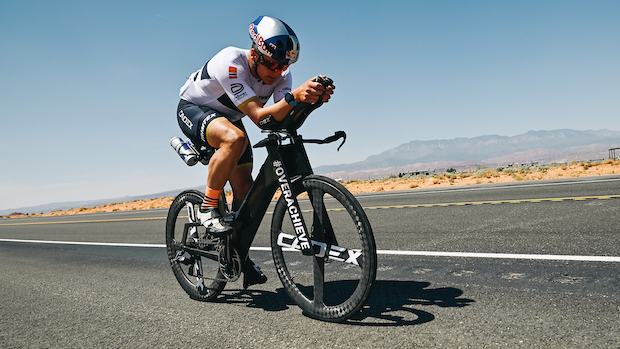
Let us return to the Shiv Disc. Below is an image of that bike and you can see what I’m writing about when I refer to fork blades that don’t terminate at the fork crown – as was the necessarily the case older-style rim brake bikes – rather the blades on the Shiv Disc keep going up until they end right at the pursuit bar and at the top of the head tube (rather at the bottom of the head tube, which is more typical).
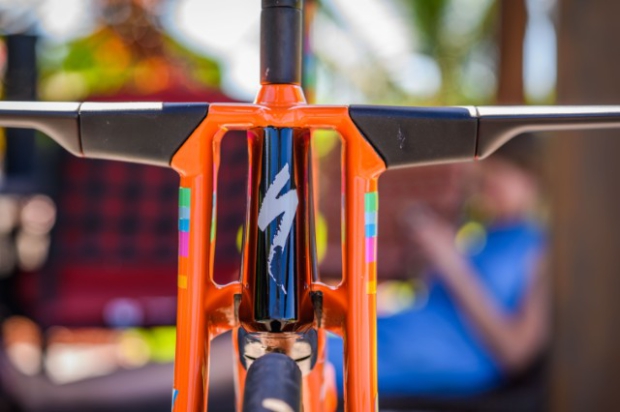
This gave the bike an odd appearance, more like the fork you’d see on a motorcycle, with fork tubes traveling through and connecting the lower and upper triple trees.
The Shiv Disc had another distinctive feature: a low-slung set of seat stays. These are not universally found on bikes of this type but they’re pretty frequent.
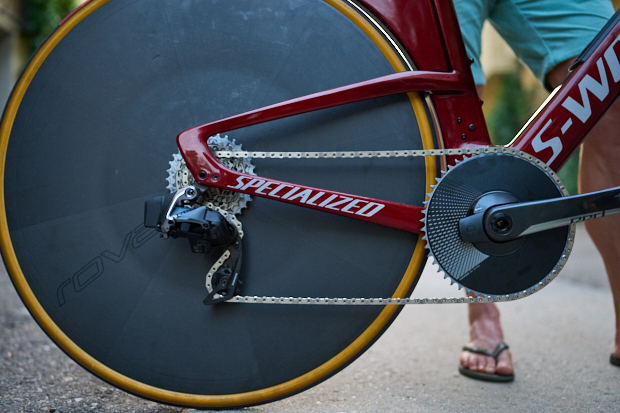
If you look at Blummenfelt’s CADEX you’ll see this low-slung stay design used in that bike as well.
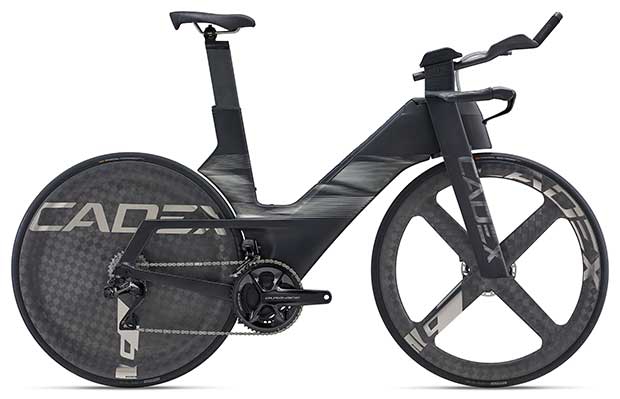
When the Shiv Disc came out it was the strangest looking bike that anyone in triathlon had seen in a long time. Maybe ever. (And I’ve got a little bit of background in strange looking tri bikes.) But that Shiv Disc looks positively normal compared to the TF1 by Kú Cycle.
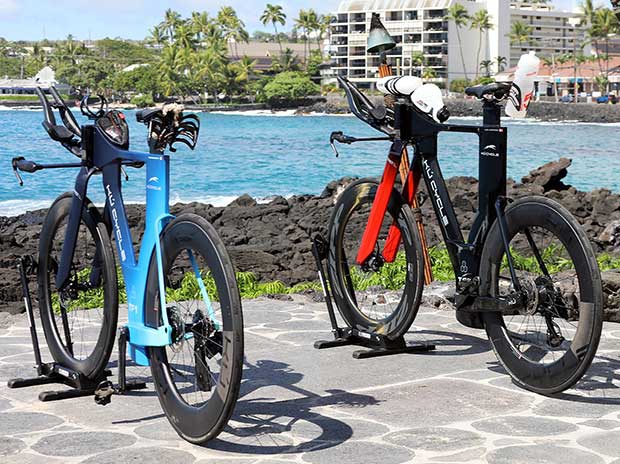
This bike was built with no consideration given to traditional frame constraints. For example, as you look at images of this bike you might ask about standover height. The folks at Kú consider this metric a casualty of more important imperatives. They simply don’t care about standover; it interferes with the aerodynamic qualities they’re after.
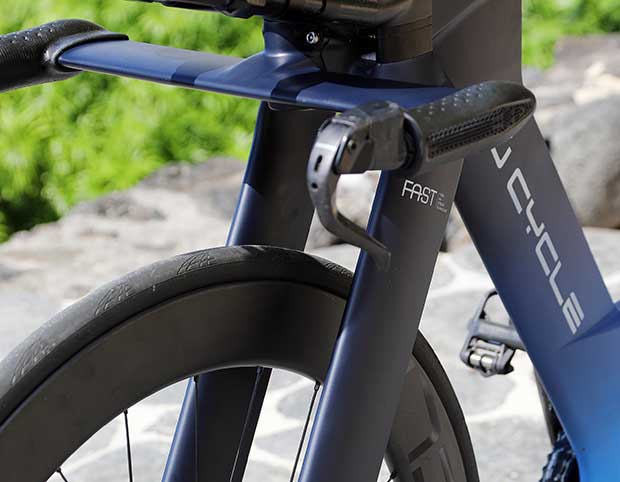
Let’s stop here and talk about why the Kú, and the CADEX, and the Shiv Disc are all made this way. The story – for me – goes back to the early 1990s. I was at the Texas A&M wind tunnel with Steve Hed and John Cobb and we were testing forks. What tested well? Forks by Lotus and Hotta and the fork used in the Hooker Elite. These were all the most highly regarded aero designs of that era. There were two forks that shouldn't have tested as well or better than the most highly regarded aero forks, but they did. One was the Schwinn fork made at its Ashtabula factory that went on its least expensive designs, like the Varsity. The thing about that fork: It was solid steel. Not made from tubes. It weighed more than your entire bike frame weighs (and I’m confident saying that without knowing what bike you ride.) That fork blade was very small, thin, and hugged the wheel.
The other fork that tested better than just about everything was a strange design by Dan Wynn, a custom builder in Washington State. This was also a steel fork, but its characteristic was its blades that remained parallel to each other, rather than tapering toward each other and meeting at the fork crown. I don’t have an image of it but the blades were – as I say – parallel to each other as they are with this Kú below, and like the CADEX. The Shiv Disc’s blades are not quite vertical.
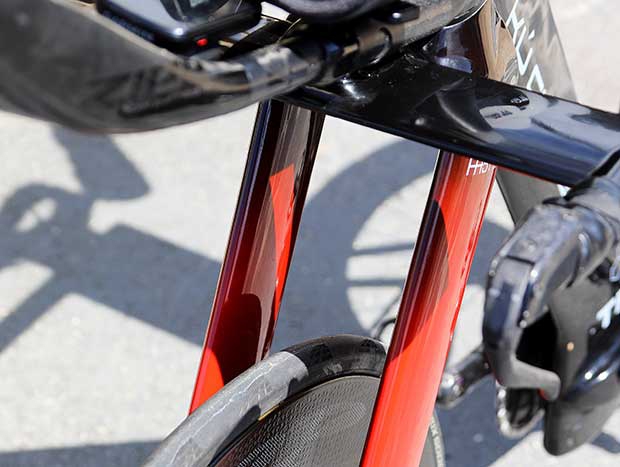
What was the point? Interference drag, and let me explain. If you look at a biplane – or a triplane – from the early days of airplane manufacture you’ll note how far apart the wings are from each other. Why? Each wing creates its own airflow and that flow needs to greet smooth air. The wing alters the airflow, and if you place the two wings of a biplane too close together the altered airflow created by each wing interferes with the other wing’s performance. Hence the large space between the wings of a multi-wing aircraft.
The front of a bike below the handlebar has 3 aerodynamic elements: each of two fork blades, and the wheel. Immediately after returning from the wind tunnel I went to work. I had a fork made by my fork supplier for the tri bikes I was making. The first version was aluminum and was uncreatively named the Illuminaero. Next came the Carbonaero. Neither was as radical as the designs you see here. Because I didn’t want to make a fork as crazy looking as these I opted for something more appealing or at least familiar to the consumer’s eye. This idea has popped up since then. See the wide forks and narrow-flanged hubs Felt introduced in 2009.
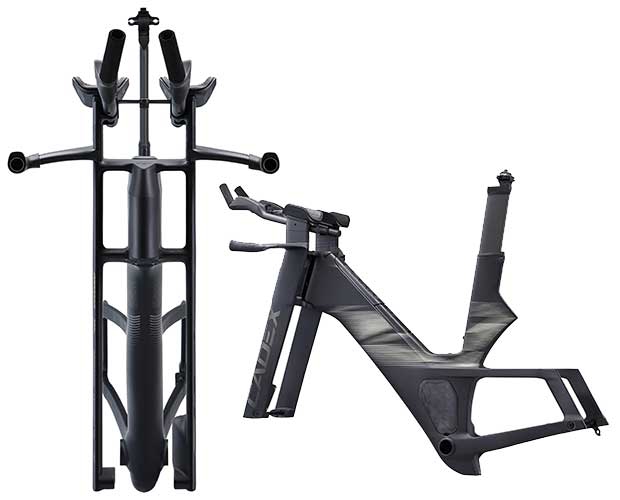
Because I felt I was selling out a little on the design, I contracted with wheel companies to make me wheels with a flange width of 60mm, rather than the typical 80mm. If I couldn’t get the fork blades all the way away from the wheel, I’d compensate by getting the wheel farther away from the fork blades. One thing you’ll note about Blummenfelt’s bike is the front wheel. See how far that 4-spoke is away from the fork, because of its narrow aspect. Anyway, that’s why I call this a triplane front end.
The rear of the bike features seat stays that are similarly far from the wheel, and/or seat stays that hit the seat tube quite low to the ground.
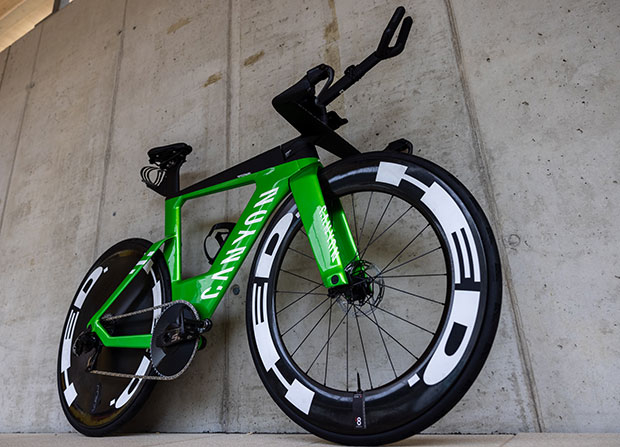
If you just can’t wrap your brain around a design of this type, in my opinion and to my eye Canyon’s most recent Speedmax design is a step in that direction. I have no good images of a Speedmax head on but this is a screenshot of Jan Frodeno in the wind tunnel and I think you can see what I mean.
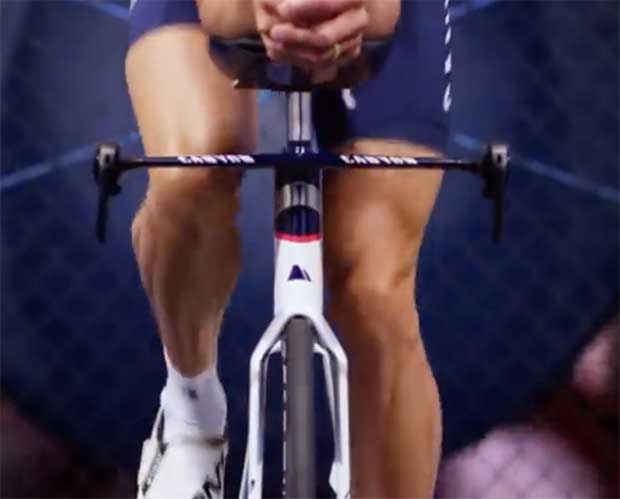
What I think we’ve learned – and I’m always open to new info, but at this point – is that the blades and stays need to really hug the wheel, to create one airflow, or they need to remain well away from the wheel. And the seat stays, and you can see Canyon has chosen the same idea for the rear of the bike.
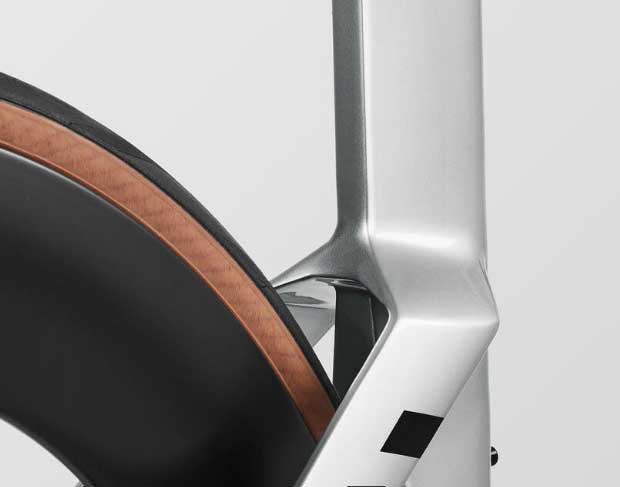
If you place the fork blades to close to the wheel, but not close enough, you risk creating a kind of dam, where the air has no room to fit in between the wheel and the blade, but the whole complex is so wide the air has to travel some distance to get around it. Or so the theory goes.
For more info on any of these bike brands, of course you know where to find your Canyon. Here's where Kú Cycle resides. There were 14 of them in the Hawaiian IRONMAN. Not quite the 783 that Canyon had, but I understand Kú's riders were quite competitive in the AG races. Kú looks very strange without riders.
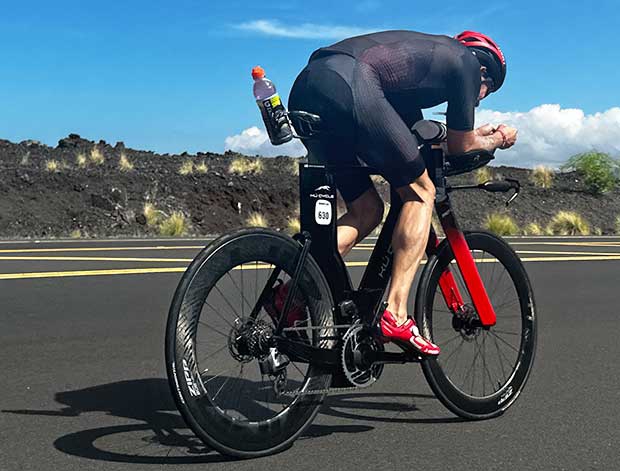
Plopping a rider aboard helps. Specialized has a history of blowing hot and cold with triathlon. When it's in it's really in. Then it's not in. I don't know where Specialized sits right now with triathlon but here's where you'll find the Shiv Disc. It would be a shame if Specialized does not power forward with this design. It took a long time for the bike to hit the streets after it was first introduced in 2018. Then came COVID, just as this bike was warming up. Here we are 4 years later and that bike, which looked extremely odd at the time, looks almost normal. It still had pros aboard that bike in Kona because it was, and is, fast. I remain of the view that it was the bike that finally leveraged Dan Wynn's striking fork design.
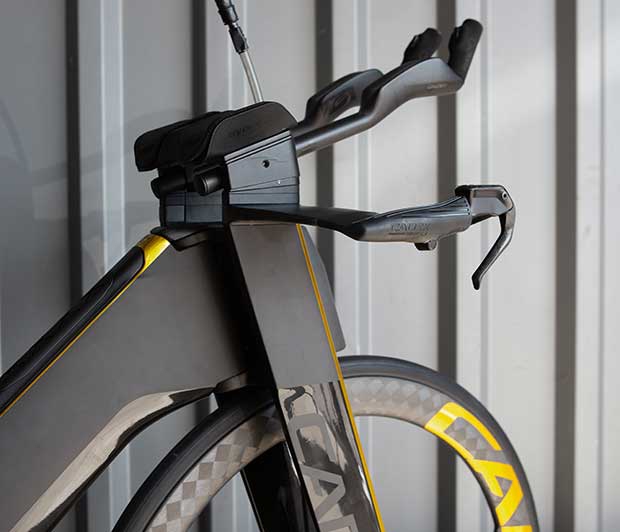
Here is where you'll find the CADEX. Several years ago James Huang wrote about the '96 Superbike project and the "lasting effect" on the bike industry, which you can find on CyclingTips if you follow that link. You'll see that top tubeless design that the CADEX features on that GT Superbike. Also note how close the fork blades were to that very narrow front axle spacing on that GT. This is the point. This is what your bike has to be – so the theory goes. It's this (like the Hooker Elite was) or you have to go wide. Either works (again, goes the theory). Hence these new designs.


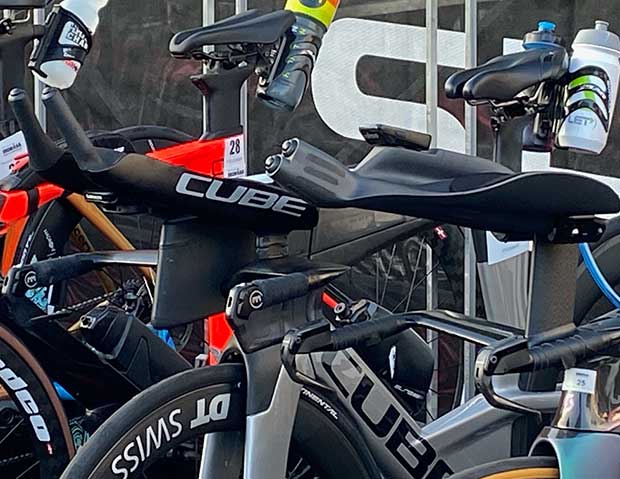
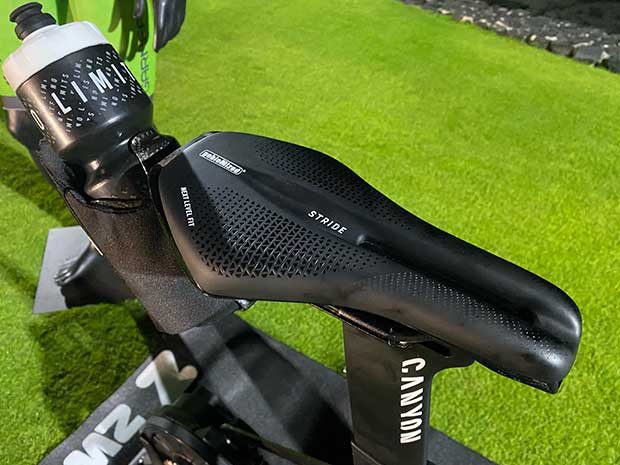
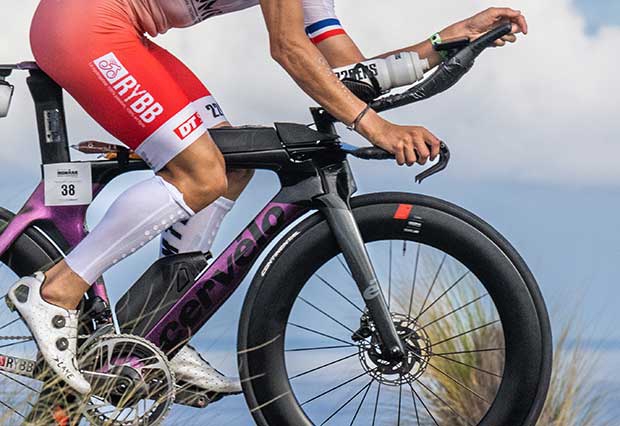
Start the discussion at slowtwitch.northend.network